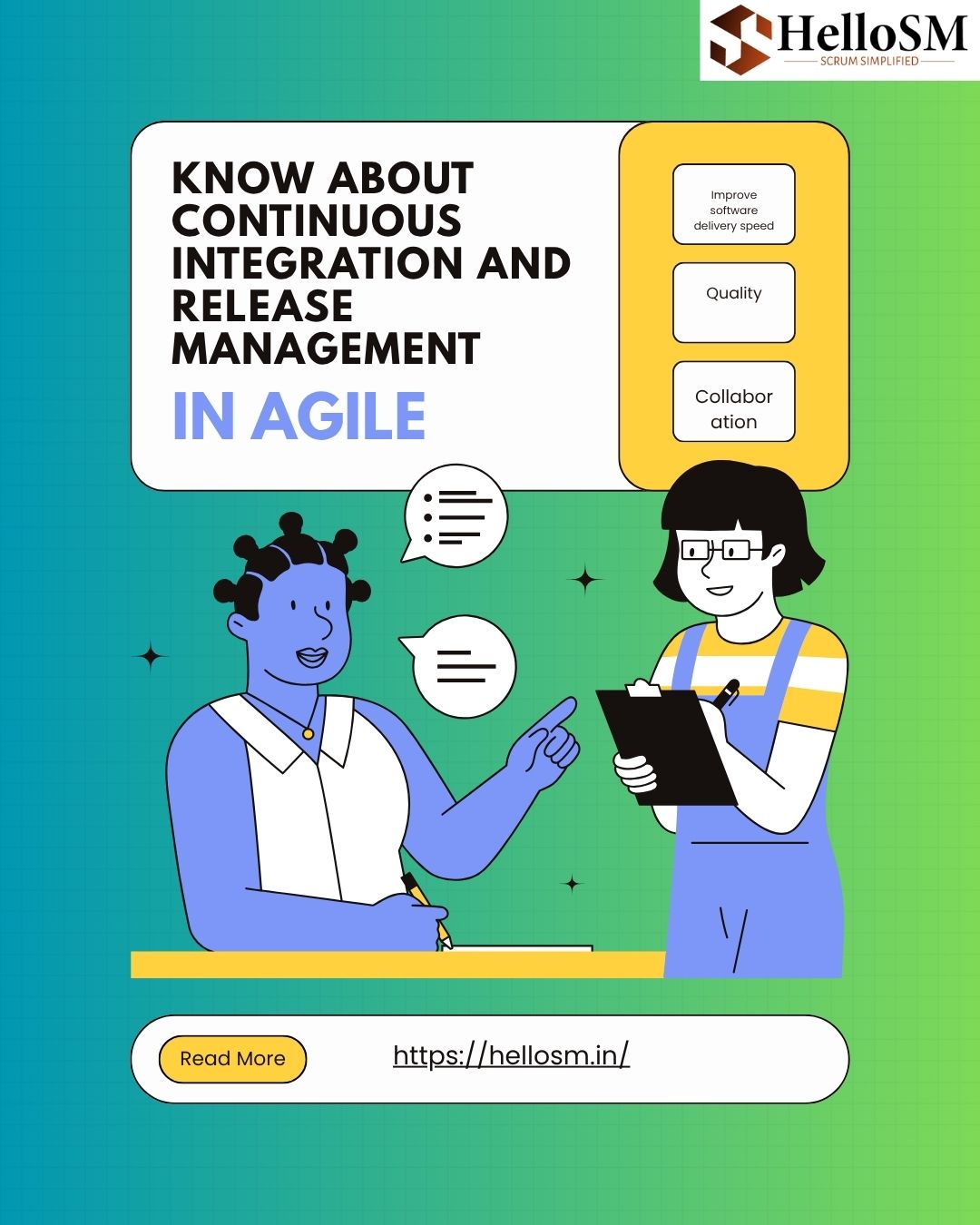In today’s fast-paced software industry, Continuous Integration (CI) and Release Management play a vital role in ensuring high-quality software delivery. Every successful Agile organization relies on these two processes to maintain speed, stability, and collaboration among teams.
If you’re learning Agile or preparing for Scrum Master certification, understanding these concepts is essential. At HelloSM, the best Scrum training institute in India, we guide professionals to master CI and Release Management through practical examples and real-world case studies.
What is Continuous Integration (CI)?
Continuous Integration (CI) is a DevOps practice where developers frequently merge their code changes into a shared main branch. Each merge automatically triggers a build and test cycle to ensure that the new code works perfectly with the existing one. A successful CI process ensures that Code changes are tested automatically. Bugs are detected early. Builds are completed in under 10 minutes. Teams maintain a reliable and deployable codebase at all times.
If a build fails, the CI system immediately stops the next steps. Developers fix the issue right away, often within minutes. This approach reduces risks and keeps development moving smoothly.
Why Continuous Integration Matters?
Faster Feedback and Higher Quality
Automated testing helps developers identify issues quickly. Since small batches of code are integrated frequently, it’s easy to pinpoint and fix bugs early.
Better Team Collaboration
CI encourages open communication between team members. Everyone works on the same codebase, which builds transparency and trust, a key Agile value taught in programs like HelloSM Scrum training institute in Mumbai.
Reduced Development Risk
Frequent integrations reduce surprises at the end of the development cycle. Teams always know the current state of the system, lowering risk and improving confidence.
Shorter Delivery Time
Since integration and testing happen continuously, software delivery becomes faster and more predictable. Teams can focus more on innovation and less on debugging.
Skill Growth and Confidence
Continuous feedback and code reviews help developers improve their coding skills and gain confidence in their work.
Challenges in Continuous Integration
Even though CI is beneficial, it can be challenging to implement effectively.
- Cultural Resistance: Traditional organizations may hesitate to shift from manual to automated workflows.
- Maintenance Overhead: Setting up and maintaining automated test pipelines requires effort and expertise.
- Error Overload: When too many build errors occur, teams might ignore them, which can lead to poor quality.
To overcome these challenges, companies should invest in proper training — such as Scrum training and certification in Chennai, where Agile and CI best practices are taught hands-on.
Best Practices for Continuous Integration
Test-Driven Development (TDD)
Write test cases before writing the actual code. This ensures that the system behaves as expected and remains easy to maintain.
Code Reviews and Pull Requests
Before merging any new code, developers submit pull requests for review. This helps identify potential issues early and maintains code quality across the team.
Pipeline Optimization
A fast CI pipeline means quicker feedback and better productivity. Developers can experiment, test, and deliver improvements faster, ensuring a smooth user experience.
Understanding Release Management
Release Management is the process of planning, building, testing, and deploying software efficiently while maintaining stability in the production environment. It ensures that new updates are delivered quickly without disrupting existing users.
Earlier, developers treated every release as a one-time project. But with Agile and CI, release management evolved into a continuous process, connecting development, testing, and operations seamlessly.
Continuous Integration and Release Management are essential pillars of Agile success. Together, they make software development faster, more reliable, and transparent. By adopting CI and structured release management, teams enhance collaboration, minimize risks, and ensure quicker delivery of high-quality software.
To master these concepts and become an expert in Agile practices, enroll in HelloSM, the top training institute in Hyderabad, recognized as one of the best Scrum training institutes in India. Whether you’re in Mumbai, Chennai, or anywhere across India, HelloSM’s Scrum training and certification programs will help you build a rewarding career in Agile project management.
Frequently Asked Questions
How does Continuous Integration benefit Agile teams?
CI helps Agile teams deliver faster by providing instant feedback on code changes. It improves collaboration, reduces bugs, and ensures that software is always in a deployable state.
What is Release Management in software development?
Release Management is the process of planning, building, testing, and deploying software updates efficiently. It ensures that new versions reach users smoothly without affecting the existing system.
What challenges do companies face while implementing CI?
Common challenges include cultural resistance to automation, difficulty maintaining pipelines, and managing frequent error notifications. These can be solved through training and strong team collaboration.
How can HelloSM help me master CI and Release Management?
HelloSM offers specialized Scrum training and certification in Chennai, Mumbai, and Hyderabad. Our courses cover real-world practices, Agile release management helping professionals build practical, job-ready skills.

